Goblin Sharks are called a living fossil because their family, Mitsukurinidae, can be traced back 125 million years.
Advertisement
Goblin Shark Scientific Classification
- Kingdom
- Animalia
- Phylum
- Chordata
- Class
- Chondrichthyes
- Order
- Lamniformes
- Family
- Mitsukurinidae
- Genus
- Mitsukurina
- Scientific Name
- Mitsukurina owstoni
Read our Complete Guide to Classification of Animals.
Goblin Shark Conservation Status
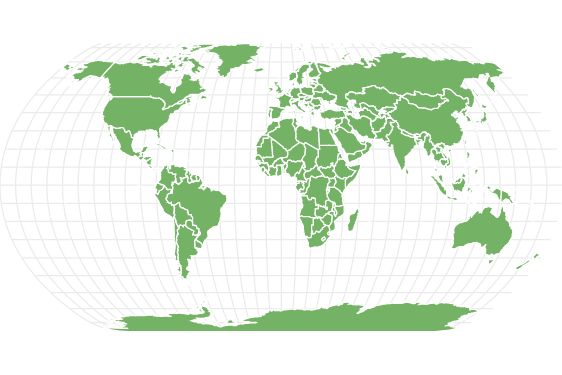
Goblin Shark Facts
- Prey
- Teoeost fish, cephalopods, and crustaceans
- Fun Fact
- Goblin Sharks are called a living fossil because their family, Mitsukurinidae, can be traced back 125 million years.
- Biggest Threat
- Blue Sharks
- Most Distinctive Feature
- Catapulting snout
- Other Name(s)
- Living Fossil
- Habitat
- Deep Sea
- Predators
- Blue Sharks
- Diet
- Carnivore
- Favorite Food
- Teoeost fish, cephalopods, and crustaceans
- Common Name
- Goblin Shark
- Number Of Species
- 1
View all of the Goblin Shark images!
The Goblin Shark, which is sometimes referred to as a living fossil, is a type of shark that is found in the deep sea.
This unique-looking shark is easily identified by its long snout, protruding jaws, and semitranslucent skin. Goblin Sharks have been found in all three of the major oceans. Because they live so deep under the water, there are still a lot of unknowns about this creature.
4 Incredible Goblin Shark Facts!
- These Sharks are able to extend their jaws to catch and bite prey more quickly than any other sharks.
- As Goblin Sharks get older, their length decreases and their color deepens.
- Goblin Sharks are called living fossils because their family, Mitsukurinidae, can be traced back 125 million years.
- These Sharks have special organs on their snouts that allow them to sense another animal’s electrical field. This helps them with hunting.
To read more interesting facts about Goblin Sharks, click here.
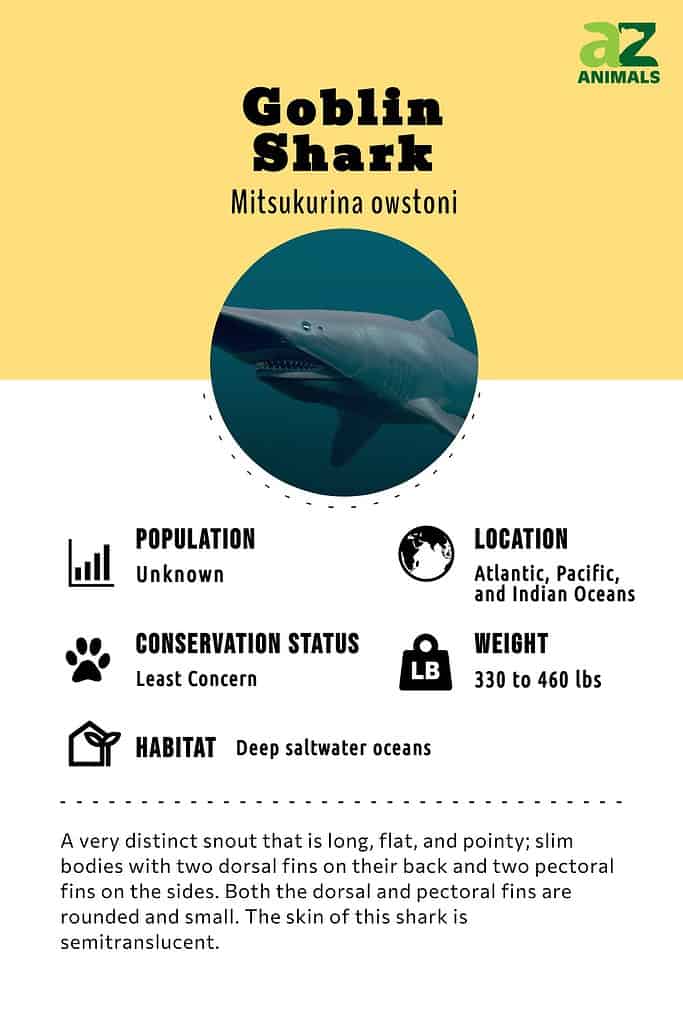
Classification And Scientific Name
The scientific name for the Goblin Shark is Mitsukurina owstoni. Mitsukurina refers to the Goblin’s Shark’s family, Mitsukurinidae. The second part of their scientific name, owstoni, was chosen in honor of Alan Owston. Owston was a collector of Asian wildlife who lived in the late 1800s and early 1900s, around the time they were first discovered.
Goblin sharks are in the order Lamniformes, the family Mitsukurinidae, and the class Chondrichthyes. The Lamniformes order is the group of sharks referred to as mackerel sharks. Some of the shark species that are in this same order include Great White Sharks, Mako Sharks, and Megamouth Sharks. Goblin Sharks are the only species in the family Mitsukurinidae
Evolution And Origin
Due to the fact that the goblin shark has been on this earth for such a long time, it is sometimes called a living fossil. It is the only member of the family Mitsukurinidae and has such an ancient family origin that it dates back to about 125 million years ago, when they evolved during the Crestaceous period. They most likely lived at the same time as the dinosaurs.
Types Of
The goblin shark is a rare species of shark of which only one species is known, although it does belong to the larger family of mackerel sharks, a diverse order which includes 15 sharks. Here are just a few of those:
- Longfin Mako Shark (Isurus paucus)
- Shortfin Mako Shark (Isurus oxyrinchus)
- Megalodon (Otodus megalodon) – extinct
- Great White Shark (Carcharodon carcharias)
Appearance
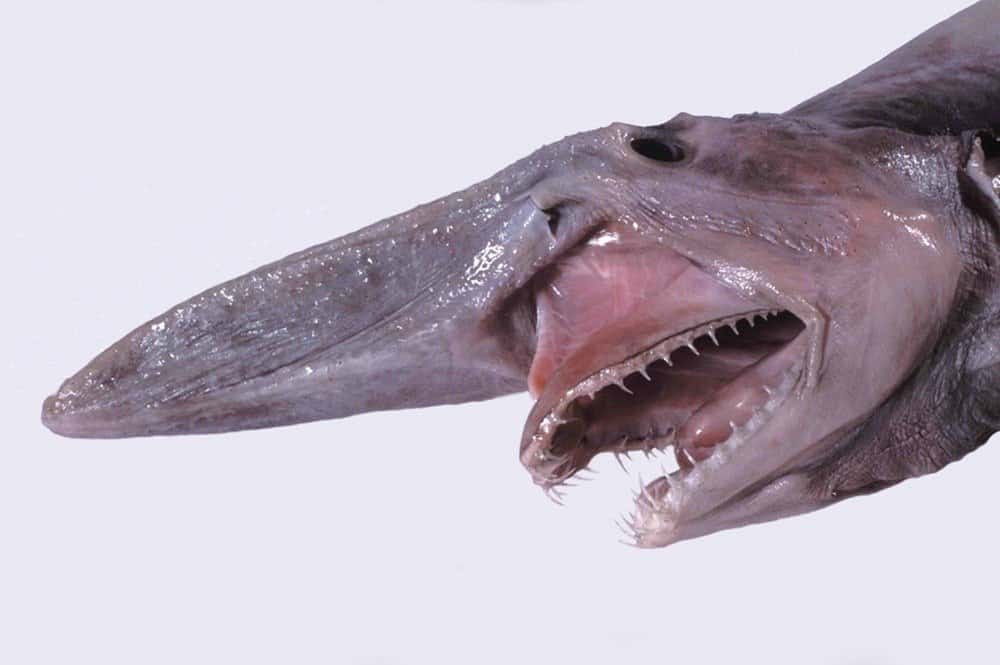
Head of a goblin shark (Mitsukurina owstoni) with jaws extended
©Dianne Bray / Museum Victoria / CC BY 3.0 AU, Wikimedia Commons – License
Snout
The Goblin Shark looks quite different from other species of sharks. They have a very distinct snout that is long, flat, and pointy. Their snout called a rostrum, is equipped with organs that are designed to help these sharks find prey in the deep, dark ocean. A Goblin Shark’s jaws are connected to ligaments within its mouth. Because of this setup, they are able to extend their jaws forward to catch prey that would otherwise be just out of their reach. After they bite their prey, the shark will return their jaws to be flush with the rest of their head.
These sharks have relatively slim bodies with two dorsal fins on their back and two pectoral fins on the sides. Both the dorsal and pectoral fins are rounded and small. The skin of this shark is semitranslucent, meaning you can almost see through it. Their semitranslucent skin makes a Goblin Shark appear to be pink or tan due to being able to see the blood vessels under their skin. Younger sharks may appear to be nearly white in color, while older members of the species will have a deeper color. The skin is covered with dermal denticles, a special type of scale, which gives it a rough texture.
An adult is typically between 9.8 and 13.1 feet long. However, in 2000, a large female shark was captured and estimated to be between 18 and 20 feet long. These sharks normally weigh between 330 and 460 pounds.
Distribution, Population, And Habitat
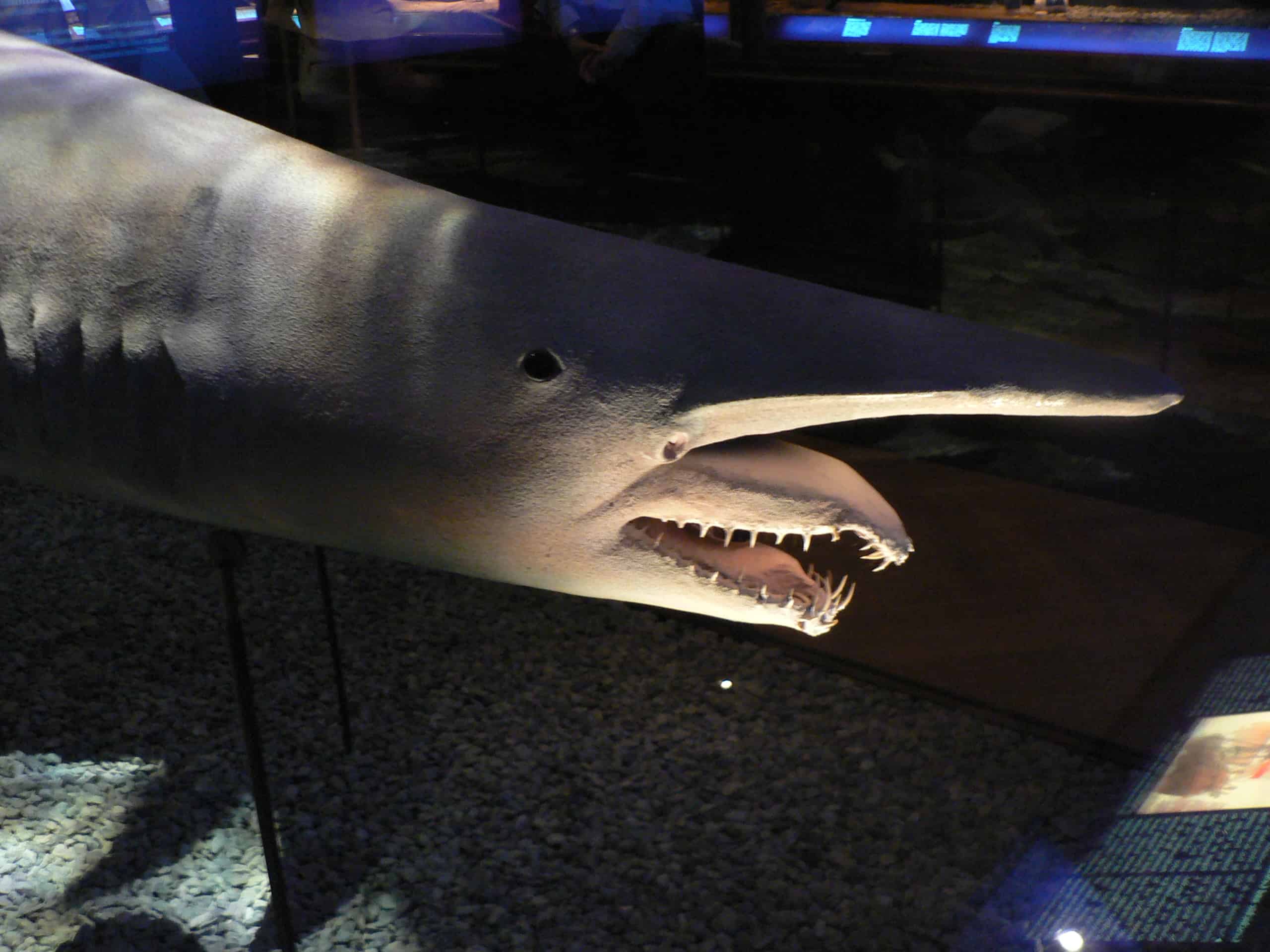
The Goblin shark lives at great depths, once caught at a depth of 4,300 feet below sea level.
©Peter Halasz / CC BY-SA 3.0 – License
These sharks tend to stay relatively deep in saltwater oceans. They prefer to swim near the upper continental slope between 890 and 3,150 feet below sea level. There are recorded instances of them being found at greater depths or closer to the surface, though. A Goblin Shark was once caught at a depth of 4,300 feet below sea level. There are also instances of these sharks being caught in fishing nets.
These sharks can be found in the Atlantic, Pacific, and Indian Oceans. They have been found near the northern Gulf of Mexico, French Guiana, Southern Brazil, Portugal, Madeira, and Senegal in the Atlantic Ocean. In the Indo-Pacific Ocean and Oceania, they have been found near South Africa, Mozambique, Taiwan, Japan, New Zealand, and Australia.
In general, juvenile sharks don’t go as deep as their adult counterparts. Younger sharks can often be found along the submarine canyons near Japan, which are at depths between 330 and 1,150 feet. Adults will often venture farther beneath the surface of the water.
Since these sharks live in the deep sea, they are not as studied as many other animals. There is still a lot that scientists need to learn about the species. We do not know how many Goblin Sharks there are, but most scientists do not believe the species is in danger. These sharks generally do not swim in areas where humans hunt and don’t seem to face many dangers caused by humans. Goblin Sharks have been given a conservation status of Least Concern by the International Union for Conservation of Nature (IUCN). New Zealand’s Department of Conservation did recently classify these sharks as At Risk due to not having enough information about their population numbers and threats.
Predators And Prey
Predators
There is not a lot of information about which other animals may be predators to these sharks. However, scientists who have studied these animals and their habitats believe that some other sharks, such as Blue Sharks, may prey on them.
What Do Goblin Sharks Eat?
These sharks eat a variety of different types of food. Dragonfishes, rattails, and other teleost fish are among some of the foods they prefer. They also eat crustaceans, such as decapods and isopods, and cephalopods. Based on the types of species that these Sharks are known to eat, including bottom- and midwater-dwelling species, it seems that they will look for food at different depths.
It is hypothesized that these sharks are ambush predators. Ambush predators rely on using strategy, rather than speed, to capture their prey. Their snouts, called rostrums, have specialized organs designed to help them find food in the low-light environment. These organs enable them to sense a fish’s electric field. When they sense an animal within their range, they use their special snout and jaws to capture it. Their jaws protrude forward very quickly to bite the prey before it suspects anything.
Reproduction And Lifespan
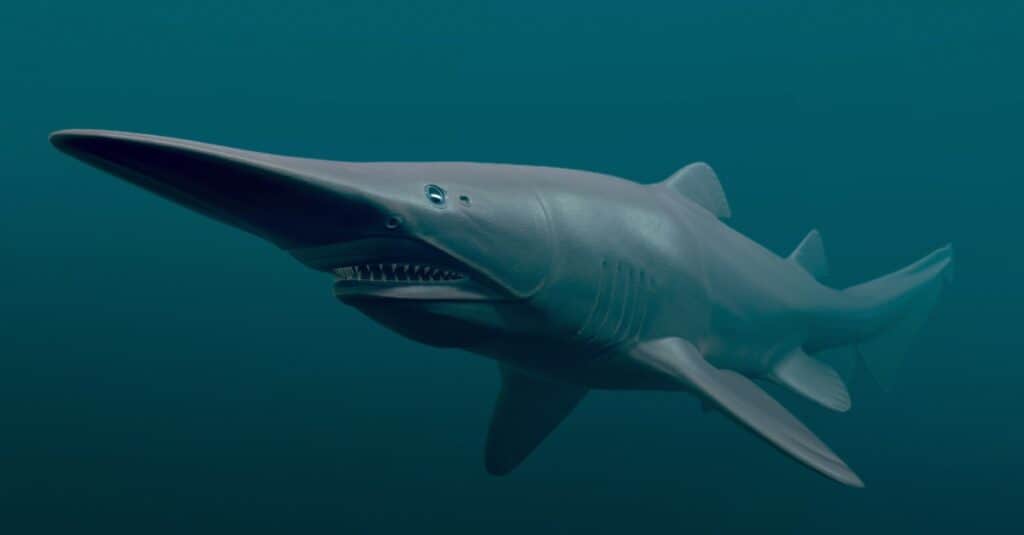
The goblin shark is believed to have similar reproductive habits to other mackerel sharks.
©iStock.com/3dsam79
Internal fertilization is the method of mating used by these sharks. While no pregnant sharks have been found to be studied, scientists believe their reproductive habits are similar to other mackerel sharks. During their gestation period, Mackerel Sharks eat undeveloped eggs that are provided by the mother; they are not connected to their mother through a placenta.
At the end of the gestation period, females give birth to a small litter of live young. When first born, a Goblin Shark is likely about 32 inches long. Once born, the shark is ready to start hunting for prey. The age for female sexual maturation is not known, and it is believed that males reach sexual maturity around the age of 16 years.
Scientists only have estimates for the lifespan of a Goblin Shark. It is believed that they can live up to 60 years.
In Fishing And Cooking
These sharks live deep below the surface of the water. People do not fish for them, but there have been a few instances of them getting accidentally caught in a fishing net. When caught, they are generally put back into the water or taken by a scientist to study. People do not cook or eat Goblin Sharks.
Population
Since Goblin Sharks live so far below the surface of the water, scientists do not have a good estimate of their population size.
View all 170 animals that start with GGoblin Shark FAQs (Frequently Asked Questions)
Where are Goblin Shark found?
Goblin Sharks can live in all three of the major oceans: the Atlantic Ocean, the Pacific Ocean, and the Indian Ocean. They live relatively deep below the surface of the water and can often be found near the upper continental slope between 890 and 3,150 feet below sea level. At times, Goblin Sharks may venture further beneath the surface of the water. One has been caught as deep as 4,300 feet below the surface. They also sometimes come to shallower water and have even been accidentally caught in fishing nets a few times.
Where do Goblin Sharks live?
Goblin Sharks have been found in the Atlantic Ocean near French Guiana, Brazil, France, Portugal, Senegal, and along the seamounts of the Mid-Atlantic Ridge. They also live in the Indo-Pacific and Oceania near Mozambique, South Africa, New Zealand, Australia, Japan, and Taiwan. Based on the areas where Goblin Sharks have found, it is pretty clear that they are widely distributed around the globe.
How deep do Goblin Sharks live?
Goblin Sharks have been caught as deep as 4,300 feet beneath the surface. Though, they are more frequently found at depths between 890 and 3,150 feet along the upper continental slope.
What eats a Goblin Shark?
There is not a lot of information about what animals are predators to the Goblin Shark. It is likely that Blue Sharks and other sharks will eat them.
How big is a Goblin Shark?
Most Goblin Sharks are between 9.8 and 13.1 feet long. They generally weigh between 330 and 460 pounds.
Are Goblin Sharks herbivores, carnivores, or omnivores?
Goblin Sharks are Carnivores, meaning they eat other animals.
What Kingdom do Goblin Sharks belong to?
Goblin Sharks belong to the Kingdom Animalia.
How fast is a Goblin Shark?
A Goblin Shark can travel at speeds of up to 15 miles per hour.
How do goblin sharks compare to other deep sea creatures?
Goblin sharks are known for their unique appearance and their jaws that extend outside their mouth to catch prey. Another deep sea creature that is popular for its uniqueness is the anglerfish. These deep sea fish have a “lure” – which is a light dangled in front of their jaws – and also have a unique way of reproducing. Males are absorbed into the females!
Thank you for reading! Have some feedback for us? Contact the AZ Animals editorial team.
Sources
- Australian Museum, Available here: https://australian.museum/learn/animals/fishes/goblin-shark-mitsukurina-owstoni/
- Wikipedia, Available here: https://en.wikipedia.org/wiki/Goblin_shark
- Eschmeyer's Catalogue of Fishes, Available here: http://researcharchive.calacademy.org/research/ichthyology/catalog/SpeciesByFamily.asp#Paralichthyidae
- National Geographic, Available here: https://kids.nationalgeographic.com/animals/fish/goblin-shark/
- Oceana, Available here: https://oceana.org/marine-life/sharks-rays/goblin-shark
- Fact Animal, Available here: https://factanimal.com/goblin-shark/
















